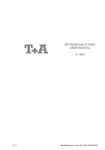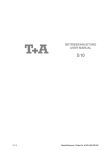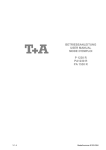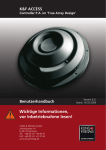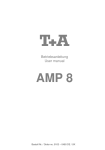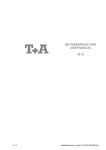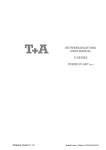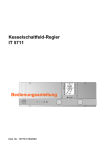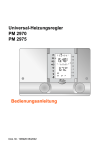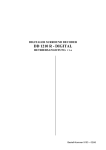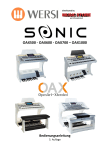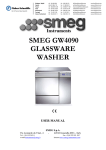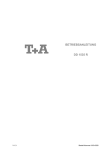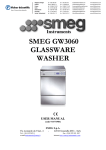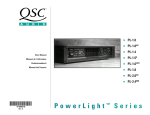Download BETRIEBSANLEITUNG USER MANUAL A 1230 A 1530
Transcript
V 1.3 / 2.0 BETRIEBSANLEITUNG USER MANUAL A 1230 A 1530 Bestell-Nummer / Order No. 9103 - 0280 2 Seite / Page Deutsch .............................................................................................................. 4 English ............................................................................................................... 20 Anhang / Appendix A: Anschlussbilder / Wiring diagrams ..................................... 36 Anhang / Appendix B: Technische Daten / Technical specifications ........... 3 41 Sehr verehrter HiFi-Freund, mit Ihrem neuen Endverstärker haben Sie ein HiFi-Gerät der Spitzenklasse erworben, bei dessen Konzeption und Entwicklung den Wünschen des audiophilen Musikliebhabers oberste Priorität eingeräumt wurde. Die innovativen Problemlösungen, die solide, durchdachte Konstruktion und die verwendeten hochwertigen Materialien werden dazu beitragen, dass dieses Gerät höchsten Anforderungen und Ansprüchen über viele Jahre genügen wird. Eine genaue Qualitätsprüfung aller Materialien, die sorgfältige Produktion durch hochqualifizierte Fachkräfte und eine rechnergesteuerte, vollautomatisierte Endkontrolle gewährleisten die hohe Produktqualität und die Einhaltung aller Spezifikationen. In unserer Geräteproduktion wird der Einsatz aller umwelt- und gesundheitsgefährdenden Stoffe, wie z.B. chlorhaltige Lösungsmittel und FCKWs, vermieden. Darüber hinaus verzichten wir wo irgend möglich auf Kunststoffe (insbesondere auf PVC) als Konstruktionselement. Statt dessen wird auf Metalle oder andere unbedenkliche Materialien zurückgegriffen, die einerseits gut recyclebar sind und andererseits eine sehr gute elektrische Abschirmung ergeben. Durch unsere massiven Ganzmetallgehäuse wird eine Beeinträchtigung der Wiedergabequalität durch äußere Störquellen ausgeschlossen. Die von den Geräten ausgehende elektromagnetische Strahlung (Elektrosmog) wird gut abgeschirmt und auf ein absolutes Minimum reduziert. Im Zubehörprogramm stehen hochwertige Kabel und Steckverbinder, sowie auf das Gerätedesign abgestimmte Tonmöbel zur Verfügung. Wir bedanken uns für Ihr Vertrauen und wünschen Ihnen viel Freude und Hörvergnügen mit Ihrem Endverstärker. elektroakustik Alle verwendeten Bauteile entsprechen den geltenden deutschen und europäischen Sicherheitsnormen und – standards. Zu Ihrer eigenen Sicherheit sollten Sie bitte unbedingt diese Betriebsanleitung vollständig lesen und insbesondere die Aufstellungs-, Betriebs- und Sicherheitshinweise genau befolgen. 4 Inhaltsverzeichnis Seite Bedienung Bedienelemente der Frontseite ............................................... 6 Fernbedienung .......................................................................... 8 Anschluss und Inbetriebnahme Anschlusselemente ................................................................. Aufstellung und Verkabelung................................................. Lautsprecher- und Signalkabel .................................................. Netzkabel und Netzfilter............................................................. Mechanische Entkopplung......................................................... Anschlussvarianten................................................................. • Mono-Brückenschaltung ....................................................... • Bi-Wiring ............................................................................... • Bi-Wiring (Brückenbetrieb).................................................... • Bi-Amping ............................................................................. Sicherheitshinweise ................................................................ Bestimmungsgemäßer Gebrauch.............................................. Gerätezulassung und Konformität mit EG-Richtlinien ............... Pflege des Gerätes .................................................................... 10 12 13 13 13 14 14 14 14 14 15 16 16 16 Sonstiges Betriebsstörungen...................................................................... 17 Anhang Anschlussbilder.......................................................................... 36 Technische Daten ...................................................................... 41 5 Bedienelemente an der Frontseite Öffnen und Schließen der Klappe (nur A 1530) Die Klappe ist mit einem Schnappmechanismus ausgerüstet. Zum Öffnen der Klappe an der gekennzeichneten Stelle leicht drücken. Die Klappe springt dann auf. Auf keinen Fall die Klappe aufziehen, denn sonst wird der Schnappmechanismus beschädigt! Zum Schließen die Klappe anheben und leicht an das Gerät drücken bis der Schnapper einrastet. (Ein- und Ausschalter) Durch Antippen des Netztasters wird der Endverstärker ein- oder ausgeschaltet. Während der Einschaltphase sind die Lautsprecherausgänge abgeschaltet. Das wird durch die abwechselnd blinkenden Leuchtdioden über den Tastern und angezeigt. Achtung! Der Netztaster ist kein Netztrenner. Auch wenn die grüne Leuchtdiode ausgeschaltet ist, sind Teile des Gerätes mit Netzspannung verbunden. Wenn der Verstärker längere Zeit nicht benutzt wird, ist es vorteilhaft, ihn durch Ziehen des Netzsteckers vom Netz zu trennen. Nach dem Wiedereinstecken des Netzsteckers befindet sich das Gerät wieder in der Einstellung, in der es sich beim Ziehen des Netzsteckers befand. Bei eingeschaltetem Gerät zeigt die grüne Leuchtdiode über dem Netztaster die Betriebsbereitschaft an. Um eine Gefährdung der Haussicherung durch eine zu schnelle Ein-/ Ausschaltfolge zu verhindern, reagiert das Gerät nach dem Ein- und Ausschalten erst nach einer Wartezeit von ca. 2 Sekunden auf das nächste Antippen des Netztasters. 6 / PHONES (nur A 1530) (Ausgangsschalter) Diese Tipptaster schalten die Lautsprecher-Ausgänge A bzw. B ein oder aus. (Kopfhörerbuchse) Anschlussbuchse für einen Stereo-Kopfhörer mit einer Impedanz von mindestens 50 Ω. Die rote Leuchtdiode über dem Taster bzw. leuchtet, wenn der entsprechende LautsprecherAusgang eingeschaltet ist. (nur A 1530) Durch Antippen dieses Tasters werden die CINCH- und die XLR-Buchsen als Stereo-Eingangsbuchsen angewählt und der Verstärker wird auf Stereo-Betrieb umgeschaltet (s. Hinweis A). (nur A 1530) Für besondere Anwendungen kann die ProtectionSchaltung unempfindlicher geschaltet werden - die angeschlossenen Lautsprecher sind dann jedoch nicht mehr so optimal geschützt! Die Leuchtdiode über dem -Taster leuchtet, wenn sich der Verstärker im Stereo-Betrieb befindet. Durch Antippen des Tasters wird zwischen der Empfindlichkeit 'NORMAL' und 'SLOW' (langsam) hinund hergeschaltet. (nur A 1530) Durch Antippen dieses Tasters wird die CINCH- Buchse L/MONO als Mono-Eingangsbuchse angewählt und der Verstärker wird auf Mono-Betrieb umgeschaltet (s. Hinweis A). Die Leuchtdiode über dem Taster leuchtet, wenn die Empfindlichkeit 'SLOW' eingestellt ist. Die Leuchtdiode über dem -Taster leuchtet, wenn im Mono-Betrieb die CINCH-Buchse angewählt ist. Hinweis: Die Leuchtdioden über den Tastern und arbeiten ebenfalls als PROTECTION-Indikatoren: Die PROTECTION-Schaltung bietet einen hervorragenden Schutz gegen nahezu jede Form der Überlastung, indem sie das Eingangssignal vor der Endstufe mit dem Ausgangssignal vergleicht und dieses bei geringen Abweichungen sofort abschaltet. (nur A 1530) Durch Antippen dieses Tasters wird die XLR- Buchse L/MONO als Mono-Eingangsbuchse angewählt und der Verstärker wird auf Mono-Betrieb umgeschaltet (s. Hinweis A). Dadurch werden die angeschlossenen Lautsprecher sehr wirkungsvoll vor Beschädigung durch Clipping oder andere signalverformende Fehler geschützt. Die Leuchtdiode über dem -Taster leuchtet, wenn im Mono-Betrieb die XLR-Buchse angewählt ist. Zusätzlich sind Schutzschaltungen gegen Kurzschluss und Überhitzung vorhanden. Wenn eine Störung auftritt, so wird das Ausgangssignal abgeschaltet und die Leuchtdioden über den Tastern und blinken abwechselnd. Hinweis A: Es kann immer nur eine Betriebsart (STEREO, MONO CINCH oder MONO XLR) angewählt sein. In diesem Fall ist sofort die Lautstärke des Verstärkers herabzusetzen. Nach etwa 20 Sekunden schaltet sich der Verstärker wieder ein und die Leuchtdioden hören auf zu blinken. Zur Unterdrückung von Umschaltgeräuschen schaltet der Verstärker während der Umschaltphase (ca. zwei Sekunden lang) die Lautsprecherausgänge ab. In dieser Zeit kann nicht in eine andere Betriebsart umgeschaltet werden. Falls sich der Verstärker nach dieser Zeit nicht wieder einschaltet, so besteht möglicherweise ein Kurzschluss in den Lautsprecher-Zuleitungen oder der Verstärker ist zu heiß geworden und sollte ggf. längere Zeit ausgeschaltet bleiben, um abzukühlen. 7 Fernbedienung HiFi TV VCR F6 F12 DISP / OFF A A/B A B B F1 'R'-Anlage in den Standby-Betrieb schalten: Der Endverstärker kann in Verbindung mit einem Voroder Vollverstärker bzw. Receiver der 'R'-Serie fernbedient werden. Die Funktionsweise der Fernbedienung innerhalb einer 'R'-Anlage ist in der Bedienungsanleitung des Mastergerätes erläutert. Die Fernbedienung F1 muss auf HiFi-Bedienung geschaltet sein; dazu die Wippe so oft antippen, bis die LED-Anzeige über HiFi leuchtet. Taster so lange gedrückt halten, bis alle Geräte der 'R'Anlage in den Standby-Betrieb abgeschaltet haben. Der Vor-/ Vollverstärker bzw. Receiver schaltet als letztes Gerät nach ca. 4 Sekunden in den Standby-Betrieb. Einschalten einer 'R'-Anlage: Zum Wiedereinschalten reicht ein kürzerer Tasterdruck (ca. 1 Sekunde). Den Taster jedoch auf jeden Fall so lange gedrückt halten, bis der Endverstärker einschaltet. Sollte dieser auf Grund schlechter Empfangsbedingungen einmal nicht mit einschalten, so ist der Taster erneut kurz (ca. eine Sekunde) zu drücken. bzw. Dieser Taster schaltet den Lautsprecher-Ausgang A bzw. B ein oder aus. Hinweis: (nur F1) Wenn das Gerät durch den -Taster an der Gerätefront ausgeschaltet wurde, so kann es auch nur durch diesen Taster und nicht durch die Fernbedienung wieder eingeschaltet werden. Dieser Taster schaltet die Lautsprecher-Ausgänge A und B gemeinsam aus. Die eingeschaltete 'R'-Anlage wird durch diesen Taster in den Standby-Betrieb geschaltet. Damit schaltet auch der Endverstärker in den Standby-Betrieb. Diese Betriebsart wird angezeigt durch die weiterhin leuchtende grüne Betriebsanzeige oberhalb des -Tasters an der Gerätefront des Vor- / Vollverstärkers oder Receivers innerhalb einer 'R'-Anlage. Die Leistungsaufnahme ist im Standby-Betrieb erheblich reduziert. 8 Installation Inbetriebnahme Sicherheitshinweise In diesem Kapitel werden alle Dinge von grundsätzlicher Bedeutung für die Aufstellung und Inbetriebnahme beschrieben, die nicht für den täglichen Umgang mit dem Gerät relevant sind, die aber trotzdem vor dem ersten Gebrauch gelesen und beachtet werden sollten. 9 Anschlusselemente INPUT CTRL IN (Signaleingänge) Steuereingang für -Geräte ohne RLINK-Ausgang. Input R / L Asymmetrischer Verstärker-Eingang mit einer EingangsEmpfindlichkeit von 1 Veff. RLINK Die Cinch-Buchsen L und R werden mit den gleichnamigen Ausgangsbuchsen des Vorverstärkers verbunden (s. Anhang A 1). Steuereingangs-/Steuerausgangsbuchsen für RLINK – System : Beide Buchsen sind gleichwertig - eine beliebige der beiden Buchsen dient als Eingang, die andere ist dann als Ausgang zum nächsten RLINK Gerät zu verwenden. Input R / L Balanced (nur A 1530) (symmetrische Signaleingänge) Eingang für Vorverstärker mit symmetrischen Ausgang. Die XLR – Buchse L und R sind mit der gleichnamigen Buchse des Vorverstärkers zu verbinden (s. Anhang A 2). Netzeingang Diese Buchse dient dem Netzanschluss und enthält die Hauptsicherung. Es dürfen nur Sicherungen verwendet werden, deren Bezeichnung mit dem Geräteaufdruck übereinstimmt! Mono Brückenbetrieb (nur A 1530) Für den Mono Brückenetrieb verwenden Sie bitte die XLR – Buchse L/Mono (s. Anschluss-Varianten und Anhang A 2). Zum korrekten Netzanschluss beachten Sie bitte die Hinweise in den Kapiteln 'Aufstellung und Verkabelung' und 'Sicherheitshinweise'. Hinweis (nur A 1530): Der A 1530 ist mit zwei Eingangsvarianten (Cinch und XLR symmetrisch) ausgestattet. Beim Anschluss darf jeweils nur eine Anschlussvariante gewählt werden. Die jeweils nicht benutzten Eingänge müssen frei bleiben. Netzschalter (Hauptschalter) Nicht in allen Modellvarianten vorhanden (abhängig vom Bestimmungsland). Der Netzschalter (sofern vorhanden) ist für den Betrieb in die Stellung 'I' zu bringen. 10 A und B Hinweis: (LS-Anschlussklemmen) Der Endverstärker kann nicht nur als normale StereoEndstufe, sondern auch in anderen Betriebsarten eingesetzt werden, z.B. im Bi-Wiring-, Bi-Amping-Betrieb oder in Mono-Brückenschaltung (nur A 1530). Die entsprechenden Anschluss-Varianten sind auf separaten Anschlussbildern dargestellt. Es können zwei Lautsprecher-Paare angeschlossen werden (SPEAKER A und SPEAKER B). Dabei darf die Impedanz jeder Box nicht kleiner als 4 Ω (nach DIN) sein. Die Endstufen sind für eine minimale Last von 2 Ω ausgelegt, jedoch können dann bei längerem Betrieb mit sehr großer Lautstärke die hohen Ströme in den Leistungsendstufen zu einer Überhitzung und damit zum automatischen Abschalten durch die Schutzschaltung führen. Es muss darauf geachtet werden, dass die Anschlussklemmen fest verschraubt sind, und keine Kurzschlüsse durch herausstehende Kabelreste entstehen. Im -Zubehörprogramm steht eine Auswahl hochwertiger Kabel zur Verfügung, die exakt auf die Geräte abgestimmt sind. Hinweis: Für die Benutzung außerhalb von Ländern der EU können die roten/schwarzen Stopfen aus den Lautsprecherklemmen entfernt werden. Der Anschluss der Lautsprecher kann dann mit Bananensteckern erfolgen. Die Stopfen sind in die Klemmen nur eingesteckt. Sie können mit einem geeigneten Werkzeug (z. B. Messerklinge) nach hinten aus der Klemme gelöst werden. 11 Aufstellung und Verkabelung Allgemeine Hinweise zur Aufstellung: Allgemeine Hinweise zur Verkabelung: Packen Sie den Gerät vorsichtig aus und heben Sie die Originalverpackung sorgfältig auf. Der Karton und das Verpackungsmaterial sind speziell für dieses Gerät konzipiert und bei späteren Transporten ein sicherer Behälter. Bitte beachten Sie unbedingt die Sicherheitshinweise dieser Anleitung. • Stecken Sie alle Stecker fest in die Buchsen ein. Lockere Steckverbindungen können Brummen oder andere Störgeräusche verursachen. • Verlegen Sie Netz- oder Lautsprecherkabel sowie Fernbedienungs-Kabel möglichst entfernt von Tonund Antennenleitungen und keinesfalls über oder unter dem Gerät. • Schließen Sie das Gerät bitte mit dem beiliegendem Netzkabel an eine entsprechende, vorschriftsmäßig geerdete Steckdose an. • Zur Erreichung des maximalen Störabstandes sollte der Netzstecker so in die Netzsteckdose gesteckt werden, dass die Phase an dem Kontakt der Netzeingangsbuchse angeschlossen wird, der mit einem Punkt () gekennzeichnet ist. Die Phase der Netzsteckdose kann mit einem dafür geeigneten Messgerät ermittelt werden. Wenden Sie sich bitte an Ihren Fachhändler. • Wir empfehlen die Verwendung der konfektionierten –Netzkabel 'POWER LINE' in Kombination mit der Netzsteckdosenleiste 'POWER BAR', die mit Phasenindikator ausgestattet ist. War das Gerät größerer Kälte ausgesetzt (z. B. beim Transport), so ist mit der Inbetriebnahme zu warten, bis sich das Gerät auf Raumtemperatur aufgewärmt hat und das Kondenswasser restlos verdunstet ist. Vor der Aufstellung des Gerätes auf empfindlichen Flächen sollte ggf. an einer nicht sichtbaren Stelle die Verträglichkeit des Lackes mit den Gerätefüßen überprüft werden. Das Gerät ist waagerecht auf einer festen, ebenen Unterlage aufzustellen. Bei Aufstellung auf Resonanzdämpfern oder Entkopplungsgliedern ist darauf zu achten, dass die Standsicherheit des Gerätes nicht beeinträchtigt wird. Die Aufstellung darf nur an einem gut belüfteten, trockenen Ort erfolgen, wobei direkte Sonneneinstrahlung und die Nähe von Heizkörpern zu vermeiden sind. Das Gerät darf nicht in der Nähe von wärmeproduzierenden, wärmeempfindlichen oder leicht brennbaren Gegenständen bzw. Geräten aufgestellt werden. Falls bei der Inbetriebnahme des Gerätes Probleme auftreten sollten, haben diese oftmals einfache Ursachen, die leicht zu beheben sind. Lesen Sie dazu das Kapitel 'Betriebsstörungen' dieser Betriebsanleitung. Ein Wärmestau beeinträchtigt die Lebensdauer des Gerätes und ist eine Gefahrenquelle! Beim Einbau in Regale oder Schränke ist dafür zu sorgen, dass durch eine ausreichende Luftzirkulation die Wärme des Gerätes abgeführt werden kann. Aus diesem Grund muss sowohl neben als auch hinter den Geräten mindestens 10 cm freier Raum zur Verfügung stehen. Über dem obersten Gerät muss ebenfalls ein Abstand von 10 cm zum nächsten Schrank- oder Regalboden eingehalten werden. 'R'-Geräte führen einen Teil ihrer Wärme über den Deckel ab. Deshalb müssen Fremdgeräte eine Fußhöhe von mindestens 2 cm aufweisen, wenn sie auf einem -Gerät der 'R'-Serie positioniert werden. 12 Lautsprecher- und Signalkabel Mechanische Entkopplung Die verwendeten Lautsprecher- und Signalkabel haben einen nicht zu unterschätzenden Einfluss auf die Wiedergabequalität der Gesamtanlage. empfiehlt daher die Verwendung hochwertiger Kabel und Steckverbinder. Die Standfläche und der Untergrund, auf dem hochwertige HiFi-Geräte aufgestellt werden, haben einen nicht zu unterschätzenden Einfluss auf die erreichbare Klangqualität. Die Standfläche sollte möglichst schwer, stabil, hart und eben sein. In unserem Zubehörprogramm finden Sie eine Reihe exzellenter Kabel und Stecker, die in ihren Eigenschaften auf unsere Lautsprecher und Elektronikkomponenten abgestimmt sind und hervorragend mit diesen harmonieren. Das Gerät wird mit den neuentwickelten - Kegelabsorberfüßen ausgeliefert. Diese Füße erreichen durch ihre inneren Dämpfungseigenschaften eine sehr gute Entkopplung des Gerätes vom Untergrund. Für schwierige und beengte Aufstellungsbedingungen finden Sie im Zubehör auch Kabel in Sonderlängen und Sonderstecker (z. B. in abgewinkelter Form), mit deren Hilfe sich fast jedes Anschluss- und Aufstellungsproblem lösen lässt. Hinweis: Durch Hinein- und Herausdrehen der - Kegelabsorberfüße kann ein optimaler Höhenausgleich bei Unebenheiten des Untergrundes erreicht werden. Netzkabel und Netzfilter Über die Netzstromversorgung gelangt nicht nur die notwendige Betriebsenergie zu Ihren Geräten, sondern oft auch Störungen von entfernten Geräten, Funk- und Computeranlagen. Das Gerät muss so justiert sein, dass es in allen Richtungen waagerecht steht. Alle Füße müssen einen festen Kontakt zum Untergrund haben; das Gerät darf nicht kippeln. Um elektromagnetische Störungen von den Geräten fern zu halten, bietet unser Zubehörprogramm das speziell abgeschirmte Netzkabel 'POWER FOUR', das konfektionierte Netzkabel mit Mantelkernfiltern 'POWER LINE' und die Netzfilterleiste 'POWER BAR'. Mit diesem Zubehör kann die Wiedergabequalität unserer Geräte in vielen Fällen nochmals gesteigert werden. Zu allen Fragen rund um die Verkabelung berät Sie gern Ihr Fachhändler kompetent, umfassend und unverbindlich. Gern senden wir Ihnen auch unser umfangreiches Informationsmaterial zu diesem Thema. 13 Anschluss-Varianten Bi-Amping (siehe Anhang A 3) Beim Bi-Amping kommen zwei separate Endverstärker zum Einsatz, die gut miteinander harmonieren müssen, d. h. Verstärkungsfaktoren, Phasengang und Phasenlage müssen absolut gleich sein. Bi-Wiring (siehe Anhang A 3) Unter Bi-Wiring versteht man eine Anschlussvariante für Lautsprecherboxen, bei der für die Signale des Bassund des Mittel- / Hochtonbereiches separate Lautsprecherkabel verwendet werden. Die Signalwege des Bass- und Mittel- / Hochtonbereiches werden bereits vor der Endstufe getrennt und separat bis zur Lautsprecherbox geführt. Voraussetzung für das Bi-Wiring ist, dass die Lautsprecherbox mit einem Bi-Wiring-Terminal ausgestattet ist. Im Terminal müssen unbedingt die Verbindungsbrücken zwischen Bass- und Mittel- / Hochtonkanal entfernt werden! Diese Betriebsart erhöht die Leistungsreserven der Endstufen, was sich besonders positiv auf die Dynamik der Anlage auswirkt. Für die gleiche Lautstärke ist eine geringere Leistung der Einzelverstärker nötig. So werden Intermodulations- und Klirrverzerrungen verringert. Wie das Anschlussbeispiel zeigt, hat der Benutzer hier die Möglichkeit, für den jeweiligen Frequenzbereich das optimale Kabel einzusetzen. Die Folge ist ein verbessertes Auflösungsvermögen und bessere räumliche Ortbarkeit. Im dargestellten Beispiel treibt ein Endverstärker beide Kanäle des Mittel- / Hochtonbereiches, während ein weiterer Endverstärker die Basslautsprecher beider Kanäle ansteuert. Aus den Lautsprecher-Terminals müssen unbedingt die Verbindungsbrücken zwischen Bass- und Mittel- / Hochtonkanal entfernt werden! Alle -Endverstärker lassen sich im Bi-Amping-Betrieb beliebig miteinander kombinieren. In einzelnen Fällen werden Sonderkabel benötigt - wenden Sie sich dazu an Ihren -Fachhändler. MONO-Brückenschaltung (nur A 1530) Bi-Wiring (Brückenbetrieb) (nur A 1530) (siehe Anhang A 4) (siehe Anhang A 4) Der Verstärker wird über den linken XLR- oder CINCHEingang mit einem Kanal des Vorverstärkers verbunden (im dargestellten Beispiel wird der XLR-Eingang benutzt). Er erhält somit ein MONO-Signal. Bei dieser Version des Bi-Wiring kommen zwei separate Endverstärker zum Einsatz, die jeweils in MONOBrückenschaltung betrieben werden. Der Verstärker wird über den linken XLR- oder CINCH-Eingang mit einem Kanal des Vorverstärkers verbunden. Er erhält somit ein MONO-Signal. Der andere Ausgangskanal des Vorverstärkers muss an einen zweiten Verstärker angeschlossen werden. Der andere Ausgangskanal des Vorverstärkers muss an einen zweiten Verstärker angeschlossen werden. Es kann nur eine Lautsprecherbox an den Ausgang A angeschlossen werden. Ihre Nennimpedanz sollte 4 Ω (nach DIN) nicht unterschreiten. Diese Betriebsart erhöht die Leistungsreserven der Anlage, was sich besonders positiv auf die Dynamik der Anlage auswirkt. Für die gleiche Lautstärke ist eine geringere Leistung der Einzelverstärker nötig. So werden Intermodulations- und Klirrverzerrungen verringert. Die Folge ist ein verbessertes Auflösungsvermögen und bessere räumliche Ortbarkeit. Dadurch, dass in dieser Betriebsart das SignalmasseSystem der Endstufen nicht mit den hohen Ausgangsströmen beaufschlagt wird, ist jede Signalverfälschung durch Spannungsabfälle auf der Masse ausgeschlossen. Dabei wird die Ausgangsleistung des Verstärkers mehr als verdoppelt. Hinweis: Beim Einsatz mehrerer Endverstärker muss darauf geachtet werden, dass sowohl alle Verstärker, als auch die anderen Komponenten der Anlage aus einer Steckdose versorgt werden, um Brummschleifen zu vermeiden. 14 Sicherheitshinweise Das Gerät darf nur vom qualifizierten Fachmann geöffnet werden. Reparaturen und das Auswechseln von Sicherungen sind von einer autorisierten Fachwerkstatt durchzuführen. Außer den in der Betriebsanleitung beschriebenen Handgriffen dürfen vom Benutzer keinerlei Arbeiten am Gerät vorgenommen werden. Alle in diesem Gerät verwendeten Bauteile entsprechen den geltenden deutschen und europäischen Sicherheitsnormen und -standards. Eine genaue Qualitätsprüfung aller Materialien, die sorgfältige Produktion, sowie die vollautomatische, rechnergesteuerte Endkontrolle eines jeden Gerätes gewährleisten die hohe Produktqualität und die Einhaltung aller Spezifikationen. Bei Beschädigungen oder bei Verdacht auf eine nicht ordnungsgemäße Funktion des Gerätes sollte sofort der Netzstecker gezogen und das Gerät zur Überprüfung in eine autorisierte Fachwerkstatt gegeben werden. Zu Ihrer eigenen Sicherheit sollten Sie bitte unbedingt diese Betriebsanleitung vollständig lesen und insbesondere die Aufstellungs-, Betriebs- und Sicherheitshinweise genau befolgen. Überspannungen im Stromversorgungsnetz, dem Kabelnetz oder auf Antennenanlagen, wie sie z. B. bei Gewittern (Blitzschlag) oder statischen Entladungen auftreten können, stellen eine Gefährdung für das Gerät dar. Das Gerät ist so aufzustellen, dass eine Berührung sämtlicher Geräteanschlüsse (insbesondere durch Kinder) ausgeschlossen ist. Die Hinweise und Angaben im Kapitel 'Aufstellung und Verkabelung' sind unbedingt zu beachten. Spezielle Vorschaltgeräte, wie Überspannungsprotektoren oder die 'Power Bar' Netzanschlussleiste, bieten einen gewissen Schutz vor Gerätebeschädigungen aus o.g. Gründen. Die für das Gerät erforderliche Stromversorgung ist dem Aufdruck an der Netzgerätebuchse zu entnehmen. An andere Stromversorgungen darf das Gerät nicht angeschlossen werden. Bei längerer Nichtbenutzung sollte der Netzstecker des Gerätes aus der Steckdose gezogen werden. Eine absolute Sicherheit vor Beschädigung durch Überspannungen kann aber nur eine vollständige Trennung des Gerätes vom Netz und den Antennenanlagen gewährleisten. Ziehen Sie zur Trennung sämtliche Netz- und Antennenstecker Ihrer HiFi Anlage bei Überspannungsgefahr (z. B. bei heraufziehenden Gewittern) aus den Steckdosen. Netzkabel müssen so verlegt werden, dass keine Gefahr der Beschädigung (z. B. durch Trittbelastung oder durch Möbelstücke) besteht. Besondere Vorsicht ist dabei an den Steckern, Verteilern und an den Anschlussstellen des Gerätes geboten. Sämtliche Netzversorgungs- und Antennenanlagen, an die das Gerät angeschlossen wird, müssen den geltenden Bestimmungen entsprechen und fachgerecht von einem zugelassenen Installationsbetrieb ausgeführt sein. Durch die Lüftungsschlitze dürfen keine Flüssigkeiten oder Fremdkörper in das Gerät gelangen. Im Inneren führt das Gerät Netzspannung, es besteht die Gefahr eines tödlichen elektrischen Schlages. Auf den Netzstecker darf keine übermäßige Krafteinwirkung ausgeübt werden. Hinweis: Viele Versicherungsgesellschaften bieten im Rahmen der Hausratversicherung eine Blitzschutzversicherung für Elektrogeräte an. Schützen Sie das Gerät vor Tropf- und Spritzwasser und stellen Sie keine Blumenvasen oder andere Gefäße mit Flüssigkeiten auf das Gerät. Wie alle Elektrogeräte so sollte auch dieses Gerät nicht unbeaufsichtigt betrieben werden. Es ist darauf zu achten, dass es für kleine Kinder unerreichbar ist. 15 Bestimmungsgemäßer Gebrauch Gerätezulassung und Konformität mit EG-Richtlinien Das Gerät ist ausschließlich zur Ton- und/oder Bildwiedergabe im Heimbereich in trockenen Räumen unter Berücksichtigung aller in dieser Anleitung gemachten Angaben bestimmt. Das Gerät entspricht im Originalzustand allen derzeit gültigen deutschen und europäischen Vorschriften. Es ist zum bestimmungsgemäßen Gebrauch in der EG zugelassen. Bei allen anderen Einsatzzwecken, insbesondere in medizinischen oder sicherheitsrelevanten Bereichen, ist vorher die Zulassung und Eignung des Gerätes für diesen Einsatz mit dem Hersteller abzuklären und schriftlich genehmigen zu lasssen. Durch das am Gerät befindliche Zeichen erklärt die Konformität mit den EG-Richtlinien RL 89/336/EWG, geändert durch RL 91/263/EWG und RL 93/68/EWG sowie RL 73/23/EWG, geändert durch RL 93/68/EWG und den daraus abgeleiteten nationalen Gesetzen. Geräte mit Rundfunk- oder Fernsehempfangsteilen dürfen im Rahmen der gültigen 'Allgemeingenehmigung für Ton- und Fernseh- Rundfunkempfänger', veröffentlicht im Amtsblatt des Bundesministers für Post und Telekommunikation, in der Bundesrepublik Deutschland betrieben werden. Die unveränderte, unverfälschte Werksserienummer muss außen am Gerät vorhanden und gut lesbar sein! Die Seriennummer ist Bestandteil unserer Konformitätserklärung und damit der Betriebszulassung des Gerätes! Serienummern am Gerät und in den original Begleitpapieren (insbesondere den Kontroll- und Garantiezertifikaten) dürfen nicht entfernt oder verändert werden und müssen übereinstimmen. Mit dem Gerät dürfen nur Aussendungen empfangen oder wiedergegeben werden, die für die Allgemeinheit bestimmt sind. Der Empfang oder die Wiedergabe anderer Aussendungen (z. B. des Polizei- oder Mobilfunks) ist nicht gestattet. Bei Verstoß gegen diese Bestimmungen gilt die Konformitätszusage von als widerrufen und ein Betrieb des Gerätes innerhalb der EG ist untersagt und aufgrund geltender EG und nationaler Gesetze unter Strafandrohung verboten. Durch Umbauten am Gerät oder durch Reparaturen oder sonstige Eingriffe von nicht von autorisierten Werkstätten oder sonstigen Dritten verliert das Gerät seine Zulassung und Betriebserlaubnis. Für die spätere Entsorgung dieses Produkts stehen örtliche Sammelstellen für Elektroschrott zur Verfügung. An das Gerät dürfen nur original Zubehörteile oder solche Zusatzgeräte angeschlossen werden, die ihrerseits zugelassen sind und allen geltenden gesetzlichen Vorschriften genügen. Pflege des Gerätes: Auch mit Zusatzgeräten oder als Teil einer Anlage darf das Gerät nur zu den im Abschnitt 'Bestimmungsgemäßer Gebrauch' genannten Anwendungen eingesetzt werden. Vor Reinigungsarbeiten am Gerät ist der Netzstecker zu ziehen. Die Oberflächen des Gerätes sollten zur Reinigung nur mit einem weichen, trockenen Tuch abgewischt werden. Verwenden Sie Lösungsmittel! keine scharfen Reinigungs- oder Vor der Wiederinbetriebnahme muss sichergestellt sein, dass keine Kurzschlüsse an den Anschlussstellen bestehen und dass alle Anschlüsse ordnungsgemäß sind. 16 Betriebsstörungen Viele Betriebsstörungen haben eine einfache Ursache, die sich leicht beheben lässt. Im folgenden Abschnitt sind einige mögliche Störungen sowie Maßnahmen zu deren Behebung aufgeführt. Sollte sich eine aufgetretene Störung durch diese Hinweise nicht beheben lassen, so ziehen Sie bitte umgehend den Netzstecker und wenden sich an eine -Fachwerkstatt. Störung: Gerät schaltet bei höheren Lautstärken wiederholt ab. Ursache 1: Überhitzung durch Wärmestau. Abhilfe: Das Gerät so aufstellen, dass eine ungehinderte Kühlluftzufuhr gewährleistet ist. Ursache 2: Überhitzung durch sprecher-Impedanz. Störung: Gerät schaltet nicht ein (grüne Leuchtdiode bleibt dunkel). Abhilfe: Die Netzsicherung in der Netzeingangsbuchse ersetzen. Es dürfen nur Sicherungen verwendet werden, deren Bezeichnung mit dem Geräteaufdruck übereinstimmt! Störung: Das Gerät lässt sich nicht bedienen. Ursache: Statische Entladungen oder starke Störimpulse (z. B. Blitzschläge) haben den Inhalt des Speichers verändert. Abhilfe: Netzstecker ziehen und nach ca. 30 Sekunden wieder einstecken. Gerät einschalten. Störung: Kein Ausgangs-Signal an den Lautsprechern, die Leuchtdioden über den Tastern und blinken abwechselnd (PROTECTION-Schaltung hat angesprochen). Ursache 1: Die PROTECTION-Schaltung hat wegen Überhitzung oder Übersteuerung abgeschaltet. Abhilfe: Lautstärke herabsetzen; wenn sich der Verstärker nach ca. 20 Sekunden nicht wieder einschaltet, ist er zu heiß geworden und sollte einige Minuten ausgeschaltet bleiben, um abzukühlen. Ursache 2: Kurzschluss in den Lautsprecherleitungen, z. B. durch herausstehende Litzenenden an den Lautsprecherklemmen oder mechanische Beschädigung des Kabels. Abhilfe: Lautsprecherkabel und –klemmen überprüfen, Litzenenden sauber verdrillen, beschädigte Kabel austauschen. Ursache 3: Übersteuerung durch schlechten Massekontakt. Abhilfe: Eingangskabel abziehen und warten, ob der ENDVERSTÄRKER wieder einschaltet; wenn ja, dann Eingangskabel überprüfen und ggf. austauschen. 17 Laut- Nur Lautsprecher mit mindestens 4 Ω DIN-normgerechter Impedanz verwenden – das entspricht einem Impedanz-Minimum von > 3.2 Ω. Störung: Flaches Klangbild, zu wenig Basswiedergabe. Ursache: Die Lautsprecherleitung eines Kanals ist verpolt angeschlossen. Abhilfe: Den Anschluss der Lautsprecherleitungen an Boxen und Lautsprecherklemmen des Verstärkers anhand des AnschlussSchemas überprüfen und ggf. korrigieren. Überprüfen und fest einstecken. Ursache 2: Durchgebrannte Netzsicherung. geringe Abhilfe: Ursache 1: Netzkabel nicht richtig angeschlossen. Abhilfe: zu 18 English 19 Dear fellow Hi-Fi enthusiast, the new power amplifier you have just purchased is a Hi-Fi component of the highest quality, which has been designed and developed with a single aim as top priority: to meet the wishes of the audiophile music lover. This unit represents our very best efforts at designing practical electronic equipment incorporating solid quality, the finest materials and components available, and our uniquely innovative approach to problem-solving. All these factors contribute to a piece of equipment which will satisfy your highest demands and your most searching requirements for a period of many years. All the materials we use are subject to painstaking quality monitoring. Our production areas are supervised by highly qualified, expert staff, and all final production units are checked comprehensively by a fully automated, computer-controlled system to ensure uniformly high quality. We guarantee that our products meet our own specifications to the full. At all stages of production we avoid the use of substances which are environmentally unsound or potentially hazardous to health, such as chlorine-based cleaning agents and CFCs. We also aim to avoid the use of plastics in general, and PVC in particular, in the design of our products. Instead we rely upon metals and other non-hazardous materials; metal components are ideal for recycling, and also provide effective electrical screening. The robust, all-metal cases which we use offer a real and practical advantage, since they exclude any possibility of external sources of interference affecting the quality of reproduction. From the opposite point of view our products' electro-magnetic radiation (electro-smog) is reduced to an absolute minimum by the outstandingly effective screening provided by the metal case. High quality leads and connectors as well as furniture going well with the units design complete the accessories. We would like to take this opportunity to thank your for the faith you have shown in our company in purchasing this product, and wish you many hours of enjoyment and sheer listening pleasure with your power amplifier. elektroakustik GmbH & Co KG All the components we use meet the European safety norms and standards which are currently valid. The operation instructions, the connection guidance and the safety notes are for your own good - please read them carefully and observe them at all times. 20 Contents Page Operation Front panel controls ................................................................... 22 Remote control handset.......................................................... 24 Using the system for the first time Back panel connections.......................................................... Installation and wiring ............................................................. Loudspeaker and signal cables ................................................. Mains cables and mains filters................................................... Mechanical de-coupling ............................................................. Wiring variants ......................................................................... • Bridged MONO wiring ........................................................ • Bi-Wiring............................................................................. • Bi-Wiring (bridged mode) ................................................... • Bi-Amping........................................................................... Safety notes ............................................................................... Approved usage......................................................................... Approval and conformity with EC directives .............................. Care of the unit .......................................................................... FCC Information to the user ...................................................... 26 28 29 29 29 30 30 30 30 30 31 32 32 32 32 General Trouble shooting ........................................................................ 33 Appendix Wiring diagrams ......................................................................... 36 Technical specifications ............................................................. 41 21 Front panel controls Opening and closing the flap (A 1530 only) The flap is fitted with a snap closure. To open the flap press lightly at the marked point; the flap will then spring open. Never pull the flap – the snap closure will be damaged! To close the flap raise it and press it lightly against the machine until the snap closure engages. (mains power button) Press the button to switch the power amplifier on and off. Caution! The mains button does not disconnect the unit from the mains supply. Even when the green LED is off, parts of the unit remain connected to the mains supply. During the power-on phase the loudspeaker outputs are switched off. This is indicated by flashing LEDs above the and buttons. If the unit is not to be used for a long period we recommend that you disconnect the mains plug at the wall socket. When you connect it to the mains again, it will still be set up as it was when you switched off. When the unit is switched on and ready to use, the green LED above the mains switch glows. To avoid overloading the domestic fuse system when the system is switched on and off too quickly, the amplifier does not respond immediately if you switch if off, then on again. Instead there is a pause lasting about two seconds before the unit comes on again. 22 / PHONES (A 1530 only) (Output switch) These press-buttons switch the loudspeaker outputs A and B on and off. Socket for stereo headphones, minimum impedance 50S. The red LED above the or button glows when the associated speaker output is switched on. (headphone socket) (A 1530 only) If you press this button the CINCH or XLR sockets are selected as the stereo input sokets, and the amplifier is switched to stereo operation (see note A). (A 1530 only) For special applications the PROTECTION circuit can be adjusted to a less sensitive setting- although this does mean that the loudspeakers are not so comprehensively protected. The LED above the button glows when the amplifier is in stereo mode. You can alternate between 'NORMAL' and 'SLOW' sensitivity by pressing the button. (A 1530 only) The LED above the button glows when sensitivity has been set to 'SLOW'. If you press this button the CINCH socket L/MONO is selected as mono input socket, and the amplifier is switched to mono operation (see note A). The LED above the button glows when the amplifier is in mono mode, with the phono socket selected. Note: The LEDs above the buttons and also act as PROTECTION indicators: The PROTECTION circuit provides outstanding protection against virtually any form of overloading or harmful event. It does this by comparing the input signal of the amplifier with its output signal, and switching it off immediately if any discrepancy is detected. (A 1530 only) If you press this button the XLR socket L/MONO is selected as the mono input socket, and the amplifier is switched to mono operation (see note A). This very effectively protects the loudspeakers connected to the amplifier from damage due to clipping or other signal-distorting errors. The LED above the button glows when the amplifier is in mono mode, with the XLR socket selected. Protective circuits are also provided to guard against short circuit and overheating. Note A: If normal operation is disturbed the output signal is switched off automatically and the LED's over the and buttons flash alternately. At any one time you can only select one mode of operation: STEREO, MONO CINCH or MONO XLR. If this should happen you should immediately reduce the volume setting of the amplifier. After about 20 seconds the amplifier will switch on again, and the LED's will cease to flash. To suppress unwanted noises when you change mode, the amplifier switches off the loudspeaker outputs for about two seconds during the transfer phase. During this period you cannot switch to a different operational mode. If the amplifier does not switch itself on again after this period, there could be a short-circuit in the loudspeaker cables, or the amplifier could have become excessively hot. In this case it should be left switched off for some time to cool down thoroughly. 23 Remote control handset HiFi TV VCR F6 F12 DISP / OFF A A/B A B B F1 Switching 'R' units to Standby state: Remote control units are available as optional extras for all units. The handset can be used to control individual Hi-Fi system components. The power amplifier can be remote-controlled in conjunction with a pre-amplifier or reciever of the 'R' series. Please refer to the operating instructions supplied with the Master unit of your 'R' series for details of how to use the remote control unit. The remote control unit F1 has to be switched to Hi-Fi control. Move the rocker to 'HiFi' position. Keep the button pressed in until all units have switched to Standby state. The pre-amplifier resp. receicer is the last unit to switch off; this takes about four seconds. Switching on 'R' units: or A brief press on the button (approx. 1 second) is enough to switch all units on. However, be sure to hold the button pressed in until the power amplifier switches itself on. If the power amplifier does not switch on, press the button again for about one second. This button switches on or off the loudspeaker outputs A or B individually. Note: (Only remote control handset F1) If the power amplifier was switched off by pressing the button at the front panel, you can only switch the amplifier on by pressing the same button again; the remote control button unit is inefficacious in this situation. This button switches off the loudspeaker outputs A or B simultaneously. The complete 'R'-system is switched to standby state by pressing this button. Pressing this button a second time switches all units on again. Standby state is indicated by the green LED at the front panel of the 'R'-system master respectively at the front of the 'R' pre-amplifier or receiver which will still be still glowing. 24 Installation Using the system for the first time Safety notes This section describes all those matters which are of fundamental importance when setting up and first using the equipment. This information is not relevant in daily use, but you should nevertheless read and note it before using the equipment for the first time. 25 Back panel connections INPUT CTRL IN (Audio signal inputs) Control input for systems without RLINK. Input R / L Unbalanced amplifier input with an input sensitivity of 1 Veff. RLINK The L and R phono sockets are connected to the output sockets on the pre-amplifier. Connect L to L, R to R (s. Appendix A 1). Control input / output for RLINK systems: Both sockets are equivalent – one is used as input, the other one serves as output towards other RLINK devices. Balanced Input R/L (A 1530 only) (symmetrical signal inputs) Input for pre-amplifiers with symmetrical output. Connect the XLR sockets L and R to the pre-amplifier sockets with the same designation (see Appendix A 2). Mains input This socket is for mains connection and contains the main fuse. The fuse should only be replaced with another fuse rated at the values printed on the amplifier. Bridged mono mode (A 1530 only) For correct connections refer to the sections 'INSTALLATION AND WIRING' and 'SAFETY NOTES'. For bridged mono operation please use the XLR socket marked L/Mono (see Wiring variants and Appendix A 2). Mains switch Note (A 1530 only): The A 1530 is equipped with two variants of input socket: Cinch and XLR symmetrical. When connecting equipment only one variant may be selected at any one time. The inputs not used must be left vacant. Not present on all model variants (depending on national safety rules). For operation the mains switch (if present) is to be switched to the position marked 'I'. 26 A and B Note: (Loudspeaker terminals) The power amplifier can be used as a normal stereo power amplifier. It can also work in various other modes of operation, such as bi-wiring and bi-amping. The wiring arrangements are shown in separate wiring diagrams. Two pairs of loudspeakers can be connected to the amplifier (SPEAKER A and SPEAKER B). The impedance of each speaker must not be lower than 4 Ω (according to DIN). The output stages are designed to cope with a minimum load of 2 Ω but continuous operation at very high volume produces high currents in the power output stages which can lead to overheating. This in turn trips the protective circuit which switches the amplifier off automatically. It is important to ensure that the terminal clamps are firmly screwed down, and that no short-circuits can occur through wire "whiskers" at the terminals. A selection of excellent cable is available as accessories matching to the units. Please ask your specialist dealer. Note: If the loudspeakers are to be used in countries outside the EU the red/black stoppers can be removed from the loudspeaker terminals. The speakers can then be connected using banana plugs. The stoppers are simply a push-fit in the terminals, and can be prised out from the rear using a suitable tool such as a knife blade. 27 Installation and wiring General notes on setting up the unit: Notes on connections: Carefully unpack the SR 1510 R and store the original packing materials carefully. The carton and packing are specially designed for this unit and will be needed again if you wish to move the equipment at any time. Please be sure to read the safety notes in these instructions. • Be sure to push all plugs firmly into their sockets. Loose connections can cause hum and other unwanted noises. • Deploy all mains leads, loudspeaker cables and remote control leads as far as possible from low-level leads (inter-connects) and aerial cables. Never route them over or under the receiver. • Connect the unit to a correctly earthed mains socket using the mains lead supplied. • To achieve maximum possible interference rejection the mains plug should be connected to the mains socket in such a way that phase is connected to the mains socket contact marked with a dot (). The phase of the mains socket can be determined using a special meter. If you are not sure about this, please ask your specialist dealer. • We recommend the use of the 'POWER LINE' ready-to-use mains lead in conjunction with the 'POWER BAR' mains distribution panel, which is fitted with a phase indicator as standard. If the unit gets very cold (e. g. when being transported), condensation may form inside it. Please do not switch it on until it has had plenty of time to warm up to room temperature, so that any condensation evaporates completely. Before placing the unit on a sensitive surface, please check the compatibility of the lacquer and the unit’s feet at a non-visible point. The surround receiver should be placed on a rigid, level base. When placing the unit on resonance absorbers or de-coupling components make sure that they do not compromise the stability of the unit. The receiver should be set up in a dry, well-ventilated site, out of direct sunlight and away from radiators. The unit must not be located close to heat-producing objects or devices, or anything which is heat-sensitive or highly inflammable. Any heat build-up will shorten the life of the unit and could be a source of danger. If you encounter problems when setting up and using the decoder for the first time, please remember that the cause is often simple, and equally simple to eliminate. Please refer to the section of these instructions entitled 'Trouble-shooting'. When installing the unit on a shelf or in a cupboard it is essential to provide an adequate flow of cooling air, to ensure that the heat produced by the unit is dissipated effectively. For this reason there must be at least 10 cm free space to both sides and behind the units. There must also be 10 cm free space above the top unit to the next shelf or cupboard section. 'R' series devices dissipate some heat through the case cover. For this reason any devices of a different make must stand on feet at least 2 cm high if they are to be stacked on an 'R' series unit (see drawing alongside). 28 Loudspeaker and signal cables Mechanical de-coupling Loudspeaker cables and signal cables (inter-connects) have a significant influence on the overall reproduction quality of your sound system, and their importance should not be under-estimated. For this reason recommends the use of high-quality cables and connectors. The quality and characteristics of the base on which your high-quality Hi-Fi equipment stands define the limits of sound quality which can be achieved. The base surface should be as heavy, rigid, hard and level as possible. This CD-Drawer is supplied with the new damping cones. This feet feature internal damping qualities which effectively de-couple the unit from the base surface. Our accessory range includes a series of excellent cables and connectors whose properties are carefully matched to our speakers and electronic units, and which harmonise outstandingly well with them. For difficult and cramped situations the range also includes special-length cables and special-purpose connectors (e. g. right-angled versions) which can be used to solve almost any problem concerning connections and system location. Note: If the base surface is uneven you can screw the standard feet in or out to set the unit exactly level. Mains cables and mains filters All units must be adjusted so that they are exactly horizontal in all directions. Check that all feet make solid contact with the base surface, i.e. that there is absolutely no tendency for the unit to wobble. The mains power supply provides the energy which your sound system equipment needs, but it also tends to carry interference from remote devices such as radio and computer systems. Our accessory range includes the specially shielded 'POWER FOUR' mains cable, ready-to-use 'POWER LINE' mains cable with integrated shell-type filters and the 'POWER BAR' mains filter distribution board which prevent electro-magnetic interference from entering your Hi-Fi system. The reproduction quality of our systems can often be further improved by using these items. If you have any questions regarding cabling please refer to your specialist dealer who will gladly give you comprehensive expert advice without obligation. We would also be happy to send you our comprehensive information pack on this subject. 29 Wiring variants Bi-Wiring (see Appendix A 3) Bi-Amping (see Appendix A 3) The term Bi-Wiring refers to an alternative method of wiring up loudspeakers, in which separate speaker leads are used to carry the signals for the bass range and the mid-range / high-frequency range. Bi-amping involves the use of two separate power amplifiers, and they must be carefully matched, i. e. amplification factors, phase response and relative phase must be absolutely identical. This system can only be used if your loudspeakers are fitted with bi-wiring terminals. It is essential to remove the bridging jumpers at the terminals. The signal paths for the bass range and the mid-range / high-frequency range are separated before they reach the power amplifiers, so that each range is handled by its own output stages, whilst remaining in separate stereo channels. As the example wiring diagram shows, the unit is designed so that you can use the optimum type of cable for each frequency range. This mode of operation increases the power reserves of the output stages, and this has a particularly positive effect on the overall dynamics of the system. For a given volume less power is required from each amplifier. This in turn reduces intermodulation effects and harmonic distortion. The result is improved resolution and better spatial location of the sound. In the example shown a power amplifier processes both channels of the mid-range / high-frequency range, while an other power amplifier handles the bass speakers for both channels. It is essential to remove the bridging plugs between the bass and mid-range/high-frequency channel at the loudspeaker terminals. All power amplifiers can be used in bi-amping mode, and combined with each other in any way you wish. The only restriction is that special cables are needed for certain arrangements - please ask your specialist dealer for details. Bridged MONO wiring (A 1530 only) Bi-Wiring (bridged mode) (A 1530 only) (see Appendix A 4) (see Appendix A 4) The amplifier is connected to one channel of the preamplifier via the XLR or phono input (in the example shown the XLR input is used). It therefore receives a MONO signal. In this variant of bi-wiring two separate power amplifiers are used, each driven in bridged MONO mode. The amplifier is connected to one channel of the pre-amplifier via the XLR or cinch input. It therefore receives a MONO signal. The pre-amplifier's other output channel must then be connected to a second amplifier. The pre-amplifier's other output channel must then be connected to a second amplifier. This method of operation increases the system's power reserves, and this has a very positive effect on the dynamics of the system. For a given volume a lower output is required from each amplifier, which in turn reduces intermodulation effects and distortion. The result is improved resolution and better spatial imaging. Only one loudspeaker can be connected to output A. Its nominal impedance must be no lower than 4 S (according to DIN). This arrangement excludes the possibility of signal coloration as a result of error signals on the ground system, since in this mode of operation the output stages' signal ground system is not subjected to high output currents. The amplifier's output power is more than doubled in this mode. Note: When using more than one power amplifier it is essential that all the amplifiers and all the other system components are connected to a single wall socket, to avoid hum due ground loops. 30 Safety notes The case should only be opened by a qualified specialist technician. Repairs and fuse replacements should be entrusted to an authorised specialist workshop. With the exception of the connections and measures described in these instructions, no work of any kind may be carried out on the amplifier by unqualified persons. All the components in this device fulfil the currently valid German and European safety norms and standards. We ensure that our products are of consistently high quality, and meet all specifications, by checking all materials rigorously for quality, using meticulous production methods and subjecting each unit to a fully automatic computer-controlled final inspection. If the unit is damaged, or if you suspect that it is not functioning correctly, immediately disconnect the mains plug at the wall socket, and ask an authorised specialist workshop to check it. For your own safety please consider it essential to read these operating instructions right through, and observe in particular the notes regarding setting up, operation and safety. The unit may be damaged by excess voltage in the power supply, the mains circuit or in aerial systems, as may occur during thunderstorms (lightning strikes) or due to static discharges. The unit must be set up in such a way that none of the connections can be touched directly (especially by children). Be sure to observe the notes and information in the section 'Installation and Wiring'. Special power supply units and excess voltage protectors such as the 'Power Bar' mains distribution panel offer some degree of protection from damage to equipment due to the hazards described above. The power supply required for this amplifier is printed on the mains supply socket. The unit must never be connected to a power supply which does not meet these specifications. If the amplifier is not to be used for a long period disconnect it from the mains supply at the wall socket. However, if you require absolute security from damage due to excess voltage, the only solution is to disconnect the unit from the mains power supply and any aerial systems. Mains leads must be deployed in such a way that there is no danger of damage to them (e. g. through persons treading on them or from furniture). Take particular care with plugs, distribution panels and connections at the amplifier. All mains power supply and aerial systems to which the unit is connected must meet the current regulations and must be installed by an approved electrical installer. Liquid or foreign bodies must never be allowed to get inside the unit through the ventilation slots. Mains voltage is present inside the unit, and any electric shock could cause serious injury or death. Never exert undue force on mains connectors. Note: Many insurance companies offer lightning damage insurance for electrical equipment as part of their household insurance service. Protect the unit from drips and splashes of water; never place flower vases or fluid containers on the unit. This device should never be used without proper supervision. This applies to any electrical unit. Take care to keep the unit out of the reach of small children. 31 Approved usage Approval and directives This device is designed exclusively for reproducing sound and/or pictures in the domestic environment. It is to be used in a dry indoor room which meets all the recommendations stated in these instructions. Where the equipment is to be used for other purposes, especially in the medical field or any field in which safety is an issue, it is essential to establish the unit’s suitability for this purpose with the manufacturer, and to obtain prior written approval for this usage. equipment which includes a radio or television receiving section must be operated within the stipulations laid down by the Post Office and the Telecommunications authorities in the country in which it is used. This unit may only be used to receive or reproduce those transmissions which are intended for public reception. The reception or reproduction of other transmissions (e.g. police radio or mobile radio broadcasts) is prohibited. In its original condition the unit meets all currently valid European regulations. It is approved for use as stipulated within the EC. By attaching the CE symbol to the unit declares its conformity with the EC directives 89/336/EEC, amended by 91/263/EEC, amended by 93/68/EEC, and also RI 73/23/EEC, amended by 93/68/EEC and the national laws based on those directives. The original, unaltered factory serial number must be present on the outside of the unit and must be clearly legible! The serial number is a constituent part of our conformity declaration and therefore of the approval for operation of the device. The serial numbers on the unit and in the original documentation supplied with it (in particular the inspection and guarantee certificates), must not be removed or modified, and must correspond. Infringing any of these conditions invalidates conformity and approval, and the unit may not be operated within the EC. Improper use of the equipment makes the user liable to penalty under current EC and national laws. Any modifications or repairs to the unit, or any other intervention by a workshop or other third party not authorised by , invalidates the approval and operational permit for the equipment. Only genuine accessories may be connected to the unit, or such auxiliary devices which are themselves approved and fulfil all currently valid legal requirements. When used in conjunction with auxiliary devices or as part of a system this unit may only be used for the purposes stated in the section 'Approved usage'. The only permissible method of disposing of this product is to take it to your local collection centre for electrical waste. Care of the unit Disconnect the mains plug at the wall socket before cleaning the case. The surfaces of the case should be wiped clean with a soft, dry cloth only. Never use solvent-based or abrasive cleaners! Before switching the unit on again, check that there are no short-circuits at the connections, and that all cables are plugged in correctly. conformity with EC FCC Information to the user (for use in the United States of America only) Class B digital device – instructions: Note: This equipment has been tested and found to comply with the limits for a Class B digital device, pursuant to Part 15 of the FCC Rules. These limits are designed to provide reasonable protection against harmful interference in a residential installation. This equipment generates, uses and can radiate radio frequency energy and, if not installed and used in accordance with the instructions, may cause harmful interference to radio communications. However, there is no guarantee that interference will not occur in a particular installation. If this equipment does cause harmful interference to radio or television reception, which can be determined by turning the equipment off and on, the user is encouraged to try to correct the interference by one or more of the following measures: - Reorient or relocate the receiving antenna. - Increase the separation between the equipment and receiver. - Connect the equipment into an outlet on a circuit different form that to which the receiver is connected. - Consult the dealer or an experienced radio/TV technician for help. 32 Trouble shooting Many problems have a simple cause and a correspondingly simple solution. The following section describes a few difficulties you may encounter, and the measures you need to take to cure them. If you find it impossible to solve a problem with the help of these notes please disconnect the unit from the mains and ask your authorised specialist dealer for advice. Problem: When volume is very high the unit switches off repeatedly. Cause 1: Overheating due to bad ventilation. Remedy: Remove obstructions to ventilation. Cause 2: Overheating due to loudspeaker impedance. Remedy: The impedance of each speaker must not be lower than 4 Ω (that means - DIN rating – an impedance minimum >3.2 Ω). Problem: Flat sound image, insufficient bass response. inadequate Problem: Amplifier does not switch on, or does not respond to the controls. Cause 1: Mains lead not plugged in correctly at amplifier or mains socket. Remedy: Check connections, push plugs in firmly Cause 2: Mains fuse burned out. Cause: Remedy: Replace the fuse in the mains input socket. Be sure to use a fuse rated at the values printed on the amplifier. The loudspeaker cables are not connected "in phase". Remedy: Refer to the wiring diagram, check the connections between the loudspeaker leads and speakers, and the speaker terminals on the amplifier. Correct where necessary. Problem: The unit cannot be operated. Cause: Static discharge or powerful interference (e. g. lightning) have corrupted the contents of the processor memory. Remedy: Disconnect the mains supply, wait about 3 minutes, and plug in again. Switch the amplifier on. Problem: No output signal at the loudspeakers, LEDs over the and buttons flash alternately (PROTECTION circuit tripped). Cause 1: The PROTECTION circuit has cut in due to overheating or excessive levels. Remedy: Reduce volume; if the amplifier does not switch on again automatically after about 20 seconds it has become too hot and should be left for a few minutes to cool off. Cause 2: Short circuit in the loudspeaker cables, e. g. projecting wire ends at the speaker terminals, or mechanical damage to the cable. Remedy: Check speaker leads and terminals, twist wire ends together neatly, replace damaged cable. Cause 3: Excessive contact. Remedy: Unplug input lead and wait to see if the power amplifier switches on again automatically. If so, check and replace input leads if necessary. levels due to poor earth 33 34 Anhang Appendix 35 Verwendung von Bananensteckern siehe Kap. 'Anschlusselemente'. Use of banana plugs: see the section entitled 'Back panel connections'. Anhang / Appendix A1 Anschluss-Schema / Wiring diagramm A 1230 Anschluss-Schema A 1530 mit asymmetrischer Signalführung (Cinchkabel). Wiring diagramm A 1530 with unbalanced signal leads (cinch leads). 36 Anhang / Appendix A2 A 1530 mit symmetrischer Signalführung (XLR-Kabel). A 1530 with balanced signal leads (XLR leads). 37 Anhang / Appendix A3 Anschluss-Varianten / Wiring variants Bi-Wiring Bi-Amping 38 Anhang / Appendix A4 Anschluss-Varianten / Wiring variants (nur A 1530 / A 1530 only) MONO-Brückenschaltung / Bridged MONO wiring Bi-Wiring (Brückenbetrieb) / Bi-Wiring (bridged mode) 39 40 Anhang / Annex B Technische Daten / Technical Specifications A 1230 A 1530 Nennleistung pro Kanal * Nominal power per channel (Stereo mode) * 8Ω 100 W 170 W 4Ω 150 W 280 W Impulsleistung pro Kanal * Peak power per channel (Stereo mode) * 8Ω 150 W 185 W 4Ω 290 W 340 W Nennleistung pro Kanal (Mono-Brückenbetrieb) * 8Ω - 500 W Nominal power per channel (bridged mono mode) * 4Ω Impulsleistung pro Kanal (Mono-Brückenbetrieb) * 8Ω Peak power per channel (bridged mono mode) * 4Ω 600 W - 700 W 900 W * Leistungsangaben: beide Kanäle gleichzeitig betrieben UNetz = 240 V (230 V Version) bzw. 120 V (115 V Version) * Power specification: both channels driven simultaneously Umains = 240 V (230 V version) or 120 V (115 V version) Leistungsbandbreite / Power bandwith: 1 Hz - 300 kHz Frequenzgang (0 .. 3 dB) / Frequency response (0 .. 3 dB): Anstiegsgeschwindigkeit Stereobetrieb / Stereo mode: Slew rate: Mono-Brückenbetrieb Bridged mono mode: 0.5 Hz - 350 kHz 60 V/µs 60 V/µs - 120 V/µs Dämpfungsfaktor / Damping factor: > 500 Geräuschspannungsabstand / Signal : noise ratio: > 110 dB > 114 dB Klirrfaktor / Distortion: < 0.001 % < 0.001 % Eingangsempfindlichkeit UA = 25 V 670 mV Input sensitivity UO = 25 V: Netzteilsiebung / PWR-Supply reservoir capacity: 90 000 µF Netzanschluss / PWR requirement: Leistungsaufnahme / Power consumption: 120 000 µF Siehe Rückwand / see print on the back panel Max. 300 VA 650 VA Standby < 1 VA < 1 VA Zum Lieferumfang gehören / Supplied with amplifier: • Netzkabel, Cinchkabel, RLINK Kabel / mains lead, phono lead, RLINK cable • Betriebsanleitung / Operating instructions • Signal- und Lautsprecherkabel / Signal and speaker leads Lieferbare Erweiterungen und Zubehör Optional accessories: • Steckverbinder / Connectors • Tonmöbel und HiFi Racks, auf Gerätedesign abgestimmt / System racks according to unit design Technische Änderungen vorbehalten. / We reserve the right to alter specifications. 41 elektroakustik GmbH & Co. KG Herford Deutschland * Germany










































